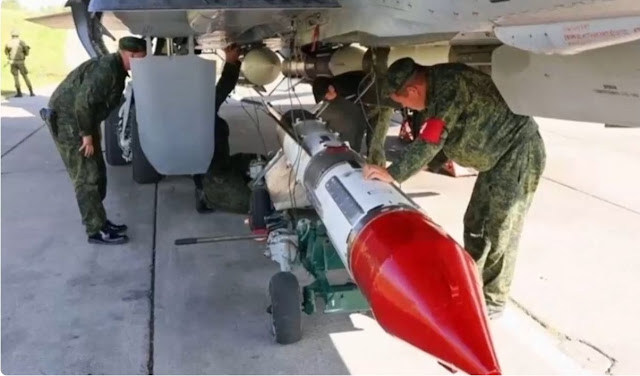Russian "Nuclear Exercise" and "Nuclear" Air to Air Missiles?
Copyright 2024 by Michael H. Maggelet
Recent news articles cite Russian news reports of ongoing "nuclear drills" and Putin's threats, which is nothing surprising given the continual exercising of Soviet forces in eastern Europe during the Cold War era (and Russian post Cold War paranoia).
A lot of emphasis has been placed stating that the MiG-31 has been armed with a nuclear version of the R-33 "Vympel" (Banner) air to air missile (NATO AA-9 "Amos"). However, none of the authoritative Russian sources that I've reviewed mention the R-33 with a nuclear warhead, and to the best of my knowledge the Soviets and Russians have never fielded a nuclear air to air missile.
While they certainly have the capability, and have produced implosion warheads down to a diameter of 5.98 inches (152mm), the R-33 missile's diameter of 15" certainly allows for a larger sized primary.
Analysis of photos and video of the R-33 involved in these loading exercises do not show markings consistent with Russian training nuclear weapons (inert load shapes), nor anything indicative of live nuclear warheads (Russian, former East German, and Hungarian web sites and books provide some interesting insight into Soviet and Russian nuclear weapons maintenance practices). There is heightened security in Russian state media videos, showing armed security and armed load crews. None of the weapons are marked in Cyrillic showing "INERT" (INERTNYY) or "TRAINING" (UCHEBNYY), thus the weapons being loaded are likely conventional R-33's.
A few months ago, Belarus media highlighted "nuclear load exercises" on Su-25 attack aircraft which were nothing more than 800 liter PTB-800 fuel tanks.
As for Russian nuclear control and release procedures, they're rather comprehensive and in the past were noted for the 12th GUMO ("Main Directorate of the Ministry of Defense") responsible for security, transportation, handling, loading, and weapons maintenance.
References-
1. "Belarus 'Nuclear Drills' Show Aircraft Fuel Tanks" by Michael H. Maggelet, Broken Arrow Blog, May 9, 2024.
2. Various authoritative articles on Russian websites do not mention a nuclear warhead for the R-33 missile. An excellent reference on the development of the MiG-31 is featured in the book "MiG-25 Foxbat and MiG-31 Foxhound- Russia's Defensive Front Line" by noted aviation author Yefim Gordon.








